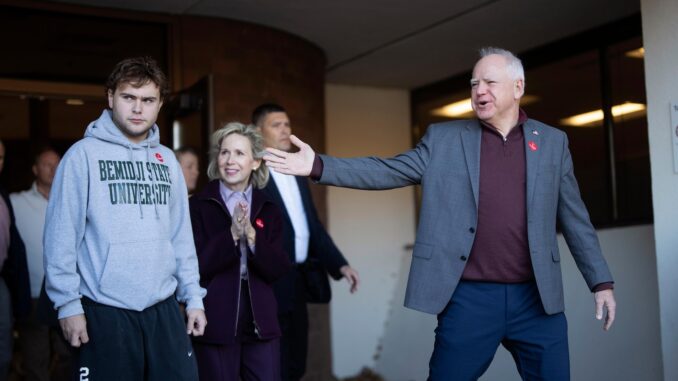
WASHINGTON — Minnesota voters will decide on Election Day how to award the state’s 10 presidential electoral votes, including whether to promote their two-term governor to the vice presidency.
Minnesota briefly loomed as a possible presidential battleground in 2024, but Democratic Vice President Kamala Harris nudged the state back onto safer Democratic ground when she chose Gov. Tim Walz as her running mate.
Republican former President Donald Trump narrowly missed winning in Minnesota in his two previous campaigns, coming within 1.5 percentage points of victory in 2016 while also picking off its midwestern cousins, Wisconsin and Michigan. This year, he suggested on multiple occasions that he would win the state, and he tried to bolster his case with campaign stops in St. Paul in May and St. Cloud in July, just days after President Joe Biden exited the race. Trump has not returned to Minnesota since Walz was named to the ticket.
Minnesota has a long history of backing Democrats for president. In the last 92 years dating back to Franklin Roosevelt’s 1932 campaign, Minnesota has only backed two Republican presidential candidates: Dwight Eisenhower in the 1950s and Richard Nixon in 1972.
Further down the ballot, voters will decide which party will control both chambers of the state Legislature. Democrats held a slim majority in the state Senate until June, when Assistant Majority Leader Kelly Morrison resigned to focus on her campaign to replace outgoing Democratic Rep. Dean Phillips in the 3rd Congressional District. Morrison’s departure left the chamber deadlocked at 33 seats each.
The special election to replace her in the Hennepin County-based district pits Democrat Ann Johnson Stewart against Republican Kathleen Fowke. Johnson Stewart is a civil engineer and former state senator elected in 2020. During her single term, the redistricting process drew her into the same district as Morrison, prompting her not to seek reelection in 2022. Fowke, a real estate agent, was the Republican nominee for this seat in 2022. She received about 44% of the vote to Morrison’s 56%. The winner in November will give her party control of the Senate for two years. No other state Senate seats are up this year.
In the state House, Republicans need only a net gain of a few seats to take control of the chamber. All 134 state House seats are up for election in November. Of those, about two dozen swing seats are at greatest risk of changing hands, according to an August analysis by the Minnesota Star Tribune.
Both the national Republican and Democratic state legislative campaign committees have indicated that winning or maintaining control of the Minnesota Legislature is a top priority for 2024.
Control of the U.S. Senate and House are also at stake on Election Day, although the races in Minnesota are not expected to determine the majority in either chamber. In the race for U.S. Senate, Democratic incumbent Amy Klobuchar seeks a fourth term against Republican Royce White. In the U.S. House, Phillips is the only incumbent not seeking reelection. The eight-member delegation is evenly divided between the parties, and the Nov. 5 election is unlikely to upset that balance.
Voters will also decide a nonpartisan state Supreme Court race and a statewide ballot measure extending an environmental trust fund.
About 27% of voters cast mail ballots in the 2022 general election. Mail ballots must arrive by Election Day in order to be counted.
The first votes in Minnesota tend to be released shortly after polls close at 9 p.m. ET. Historically, these initial batches of votes tend to include a mix of votes cast early in-person, by mail and on Election Day at a polling place.
Here’s a look at what to expect in the 2024 election in Minnesota:
Nov. 5.
9 p.m. ET.
10 awarded to statewide winner.
President: Harris (D) vs. Trump (R) vs. Chase Oliver (Libertarian) vs. Robert F. Kennedy Jr. (We the People) vs. Jill Stein (Green) vs. Cornel West (Justice for All) and three others.
U.S. Senate: Amy Klobuchar (D) vs. Royce White (R) and two others.
U.S. House, state House, state Supreme Court and one ballot measure.
2020: Biden (D) 53%, Trump (R) 45%, AP race call: Wednesday, Nov. 4, 2020, 12:13 a.m. ET.
Registered voters: 3,660,001 (as of Oct. 1, 2024).
Voter turnout in 2020 presidential election: 85% of registered voters.
Votes cast before Election Day 2020: about 58% of the total vote.
Votes cast before Election Day 2022: about 27% of the total vote.
Votes cast before Election Day 2024: See AP Advance Vote tracker.
First votes reported, Nov. 3, 2020: 9:08 p.m. ET.
By midnight ET: about 66% of total votes cast were reported.
___
AP writers Hannah Fingerhut and Maya Sweedler contributed to this report.
___
Read more about how U.S. elections work at Explaining Election 2024, a series from The Associated Press aimed at helping make sense of the American democracy. The AP receives support from several private foundations to enhance its explanatory coverage of elections and democracy. See more about AP’s democracy initiative here. The AP is solely responsible for all content.


Be the first to comment